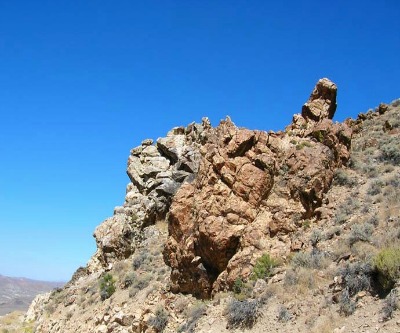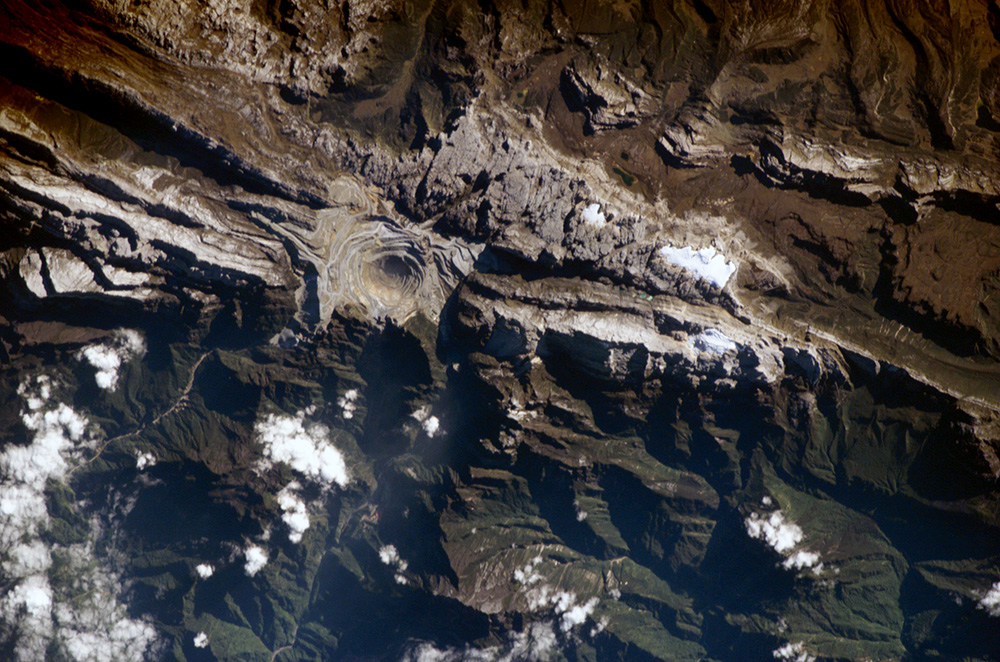Stansberry’s Matt Badiali shares his guide to avoiding pitfalls in the climb to resource investing heights

 Successful resource investors have to make their way past a lot of money pits before they find a stock that will make it to the top. In this interview with The Gold Report, S&A Resource Report Editor Matt Badiali shares the red flags wedged in PEAs and points to a handful of companies that are building shareholder value.
Successful resource investors have to make their way past a lot of money pits before they find a stock that will make it to the top. In this interview with The Gold Report, S&A Resource Report Editor Matt Badiali shares the red flags wedged in PEAs and points to a handful of companies that are building shareholder value.
The Gold Report: You’ve said that natural resource investors need to be open to opportunities wherever they occur. How do you separate the hype from fact to determine a real bargain?
Matt Badiali: My secret is research. I’m a scientist. I love digging in the dirt and looking in places where other people don’t want to look for opportunities. I also have a secret weapon in that I work with a guy who is a forensic accountant. He can read a balance sheet and annual and quarterly reports and spot the trouble spots. He warns me of any potential land mines.
TGR: What are the red flags you find most often?
MB: Debt is a big one. You have to be wary of natural resources companies piling on debt. Miners have no say in what they will be paid for the material they are selling. If you mine gold, you are paid whatever the gold price is that day. You are a price taker as opposed to Apple, which sets the price of the iPhone at $700 and that is what it thinks the market will pay. Debt is a fixed cost that has to be paid regardless of the price of gold or silver. Investors have to figure out whether a company can sustain itself based on the cash coming in and the money going out.
TGR: You also have the luxury of being able to visit these projects and talk to the CEOs, to the geologists. Conferences like the Sprott/Stansberry Vancouver Natural Resources Symposium, where you will be speaking, allow investors to talk to company representatives. We recently interviewed Rick Rule and Porter Stansberry. Rick talked about some of the questions that he asks when he’s face to face with companies. What are the questions you think investors should be asking when they get the chance to meet with a junior mining company representative?
MB: The number one question is “What is your burn rate?” I need to know how much money a company is going to spend this year. The second question is “How much money do you have in the bank?” Companies are notorious for having $ 2 million ($2M) in the bank and a $6M burn rate. Often the plan is to make up the difference by selling a bunch more shares. That is when I turn on my heel and walk away. I would rather buy after the company has diluted the current investors.
We wrote a report called “A Guide to Avoiding the Most Popular Mining Scam in the World.” It dissects the smoke and mirrors in preliminary economic assessments (PEAs), the reports required by the Canadian Securities Administrator after the Bre-X scandal. The goal was to force mining companies to disclose their economics, assay results, everything. Actually, all they really did was facilitate more frauds because companies find a way to say whatever they want in PEAs.
Often a PEA states that when a mine is built, it will be worth a bazillion dollars. But the truth is buried in the details. Many will assume $1,500/ounce ($1,500/oz) gold prices when reality is $1,200/oz today. Or they use a pretax estimate or an undiscounted present value for a mine that will operate over 30 years. There are lots of ways for folks to manipulate these things.
TGR: Has picking winners gotten easier now that there are fewer companies to choose from? Has the bifurcation that Rick Rule has talked about happened?
MB: It is a lot easier today to see which companies have real assets, real value. There is absolutely a group of companies that have been lost in the declines in the price of gold and the general rout of mining stocks. What I’m looking for right now are real assets, like major discoveries or mines that are in the process of being built.
Fission Uranium Corp. (FCU:TSX) is a junior mining company with a giant uranium deposit, Patterson Lake South, in the Athabasca Basin of Canada. It’s in the process of advancing this project and creating enormous value for shareholders. The stock is up 12% since January while most of the mining sector has just been absolutely crushed.
Dalradian Resources Inc. (DNA:TSX) has a nice little gold discovery in Northern Ireland, Curraghinalt. From January to today, it’s up 36%. These are companies with real projects.
A great example of a stock that got lost in building a mine is Pretium Resources Inc. (PVG:TSX; PVG:NYSE). This is high-grade gold. It is going to be an extremely economic mine. CEO Bob Quartermain is doing an outstanding job of advancing the Brucejack project in British Columbia.
If you’re going to buy any gold stock this year, don’t mess with Newmont Mining Corp. (NEM:NYSE) or Barrick Gold Corp. (ABX:TSX; ABX:NYSE). Don’t mess with penny stocks. Buy Pretium. That stock will make you a lot of money in a bull market.
Bob Quartermain proved himself to be a wealth creator in his last job, as CEO of Silver Standard Resources Inc. (SSO:TSX; SSRI:NASDAQ). He has a tiger by the tail with this deposit. Brucejack is ridiculous. Valley of the Kings, which is part of the Brucejack project, is underground now, and it is drilling out more of this high-grade gold. This is a tremendous opportunity. At $6-and-change, the stock could easily double. This is one where we’ll look back and say, gosh, why didn’t we buy more.
TGR: Are you finding these hidden gems in places other than Canada?
MB: Absolutely. Reservoir Minerals Inc. (RMC:TSX.V) is a great example of a company that has a massive deposit in eastern Serbia. It is a small exploration company right now. It was a $6 stock not that long ago, but it fell as low as $3.50/share. It is trading at $4+/share now. It has the massive Timok deposit that it is in the process of outlining as a joint venture. Most of its costs are being carried by its partner, Freeport-McMoRan Copper & Gold Inc. (FCX:NYSE).
Reservoir is run by smart people and has several other peripheral deposits. This is not a high-risk, hope-they-find-something speculation. This is not one of the stocks that is falling because it was selling a dream based on moose pasture up where Santa Claus lives. This is a company that has an asset that it’s developing with a major partner. I think it’s a really good buy right now.
TGR: In a difficult capital market, some miners turn to royalty and streaming companies to make up the difference between their balance sheet and their burn rate. Has the nature of royalty deals changed during the current market cycle?
MB: At its core, a royalty is the right to a percentage of the production of a mine without the obligation of paying the costs associated with that. If I own a 2% royalty on a mine that produces 100 oz of gold a month, I get 2 oz of gold a month or the value of that if it’s sold. And I don’t have to pay for the costs. So I just get 2 oz of gold in my hands because that’s my royalty.
Over the last decade or so, royalty deals morphed into what are now called streaming deals where I agree to pay you some amount of money for those 2 oz of gold. Maybe I pay you $400/oz, and then I get all the upside after $400/oz. I’m not as big a fan of streaming deals because they introduce commodity risk into the royalty model. The pure royalty models are wonderful, like a lot of the oil royalties, because they’re basically free cash coming into the business. There is almost no cost of revenue, so most of it goes straight to the bottom line.
The two best royalty companies in the mining space are Royal Gold Inc. (RGLD:NASDAQ; RGL:TSX) and Franco-Nevada Corp. (FNV:TSX; FNV:NYSE). I like to point to Royal Gold as my best example because it has been around the longest. In 2001, you could buy shares of Royal Gold for under $2.50/share. Today, they are trading for $62. That’s a pretty nice 15-year run. If you have some smart folks running it and they’re able to recycle their cash flow into acquiring more royalties, the company grows very quickly. I like that model.
I like it so much that we recently bought Osisko Gold Royalties Ltd. (OR:TSX), one of the newest of the royalty models. Again, it’s run by some really smart people. We bought in December 2014, and it’s up slightly, up 10%. I think that it is still a good buy because if the company can execute the same strategy that Royal Gold used to go from $2.50 to $60/share, people who get in today should be in line for triple-digit or more gains. This is one where I would like to buy these shares and put them in a trust for my kids because I think that’s the right way to own them, just leave them alone and not worry about the wiggles.
TGR: Any comforting words you can offer investors trying to outlast the wiggles in the market today?
MB: When you hike to the top of the mountain, you don’t worry about the gullies. You just look at the peak and say that’s where I’m headed, and that’s where these things are headed.
The things that I am most excited about right now are the companies that have big, robust deposits and are building mines. Those are the companies that are going to benefit most from the coming market cycles.
TGR: Thank you for your time, Matt.
Matt Badiali is the editor of the S&A Resource Report, a monthly investment advisory that focuses on natural resources, including silver, uranium, copper, natural gas, oil, water and gold. He is a regular contributor to Growth Stock Wire, a free pre-market briefing on the day’s most profitable trading opportunities. Badiali has experience as a hydrologist, geologist and consultant to the oil industry. He holds a master’s degree in geology from Florida Atlantic University.
Want to read more Gold Report interviews like this? Sign up for our free e-newsletter, and you’ll learn when new articles have been published. To see a list of recent interviews with industry analysts and commentators, visit our Streetwise Interviews page.
Source: JT Long of The Gold Report
DISCLOSURE:
1) JT Long conducted this interview for Streetwise Reports LLC, publisher of The Gold Report, The Energy Report and The Life Sciences Report, and provides services to Streetwise Reports as an employee. She owns, or her family owns, shares of the following companies mentioned in this interview: None.
2) The following companies mentioned in the interview are sponsors of Streetwise Reports: Fission Uranium Corp. and Pretium Resources Inc. Franco-Nevada Corp. is not associated with Streetwise Reports. The companies mentioned in this interview were not involved in any aspect of the interview preparation or post-interview editing so the expert could speak independently about the sector. Streetwise Reports does not accept stock in exchange for its services.
3) Matt Badiali: I own, or my family owns, shares of the following companies mentioned in this interview: None. I personally am, or my family is, paid by the following companies mentioned in this interview: None. My company has a financial relationship with the following companies mentioned in this interview: None. I was not paid by Streetwise Reports for participating in this interview. Comments and opinions expressed are my own comments and opinions. I determined and had final say over which companies would be included in the interview based on my research, understanding of the sector and interview theme. I had the opportunity to review the interview for accuracy as of the date of the interview and am responsible for the content of the interview.
4) Interviews are edited for clarity. Streetwise Reports does not make editorial comments or change experts’ statements without their consent.
5) The interview does not constitute investment advice. Each reader is encouraged to consult with his or her individual financial professional and any action a reader takes as a result of information presented here is his or her own responsibility. By opening this page, each reader accepts and agrees to Streetwise Reports’ terms of use and full legal disclaimer.
6) From time to time, Streetwise Reports LLC and its directors, officers, employees or members of their families, as well as persons interviewed for articles and interviews on the site, may have a long or short position in securities mentioned. Directors, officers, employees or members of their families are prohibited from making purchases and/or sales of those securities in the open market or otherwise during the up-to-four-week interval from the time of the interview until after it publishes.
Streetwise – The Gold Report is Copyright © 2015 by Streetwise Reports LLC. All rights are reserved. Streetwise Reports LLC hereby grants an unrestricted license to use or disseminate this copyrighted material (i) only in whole (and always including this disclaimer), but (ii) never in part.
Streetwise Reports LLC does not guarantee the accuracy or thoroughness of the information reported.
Streetwise Reports LLC receives a fee from companies that are listed on the home page in the In This Issue section. Their sponsor pages may be considered advertising for the purposes of 18 U.S.C. 1734.
Participating companies provide the logos used in The Gold Report. These logos are trademarks and are the property of the individual companies.
More News
{{ commodity.name }}
{{ post.title }}
{{ post.date }}



Comments